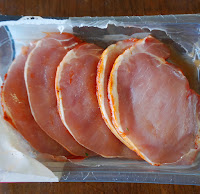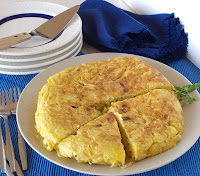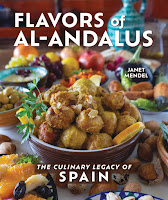Have you been following the CNN series, Searching for Spain,” presented by actress Eva Longoria? According to the network, the programs take you “across Spain’s sun-drenched plains, rugged mountains and dramatic seascapes to explore its incredible wealth of cultures, climates and cuisines.” The award-winning actress explores "firsthand how the country went from culinary obscurity to extraordinary new heights.”
With Chef Dani García, Longoria learns how to make espetones, skewered sardines wood-fire roasted at a Marbella beach, and with Chef Ferran Adrià she samples suquet, a rustic Catalan seafood stew.
As a follow-up, CNN posted a list of 14 Spanish dishes everyone should try. I’ve got the list covered! Here are my recipes for most of them.
1. Paella Valenciana. Two varieties are on the CNN list, paella with rabbit and chicken; and seafood paella. No sausage in either one!
Here's my recipe for authentic paella (no snails, though). Real saffron gives the rice its color, and, yes, I have instructions for the socarrat, the crust on the bottom of the rice as well. I tell you about the different varieties of rice and the care of a paella pan.
2.
Patatas Bravas (fried potatoes with spicy sauce). A tapas bar specialty found all over Spain, but especially popular in Madrid. Actually, there are many variations of the spicy "brava" sauce. My version here has tomatoes and lots of pimentón, smoked paprika, both sweet and hot. The recipe is
here.
3.
Gazpacho. Andalusia's signature dish, a cold "liquid salad," perfect for summer days. Here's a recipe for
Andalusian Gazpacho , first in a series about gazpacho. Be sure to see the sequel for more about choosing the ingredients (the extra virgin olive oil is so important) and for variations on the classic.
4.
Pimientos de Padrón (Padrón green peppers). These peppers, grown in Galicia in northwest Spain, are picked while still green and very small. Although they somewhat resemble jalapeños, they are bittersweet in flavor--with the exception of an occasional one that is spicy-hot. Find out to prepare them on this post,
Fried Padrón Peppers.
5.
Fideuá. (fideo noodles with seafood). Fideuá is a pasta dish, usually with seafood, that is often made like paella, in a wide flat pan. The thin noodles cook right in the flavorful seafood broth. See the recipe
here. Here's a vegetarian fideuá
Noodles with Tofu and Vegetables.
6.
Jamón. Ham, but not just any ham--the world's best, made from the ibérico breed of pig, sometimes called
pata negra, black hoof, or Jabugo, for one of the places (Andalusia) where the pigs are raised and the hams cured. More about ibérico ham and pork
here.
7.
Tortillas (potato tortilla). In Spain a tortilla is not the familiar corn or wheat flat bread used for tacos but a thick, round flat omelet of eggs and potatoes. It is favorite fare for lunch, supper, picnics, and tapas. Here's the
classic potato tortilla recipe, but there are many variations, with chorizo, with spinach, with fava beans or seaweed.
8.
Churros. Churros are strips of fried dough usually sprinkled with sugar. They are served for breakfast or at the end of late-night partying. Especially delicious dipped in thick, hot chocolate. I leave churro-making to the pros. When I was testing the churros recipe for one of my cookbooks, I repeatedly had the batter explode in the frying oil! I quit trying and substituted a recipe for
buñuelos, another type of fritter, also popular as a street food. More about how churros are made
here.
9.
Croquetas (croquettes). Any tapas bar worth its salt will have a selection of croquettes, real crowd-pleasers. Get the recipes for three kinds of croquettes
here.
10.
Albóndigas (meatballs). The CNN list for 14 Spanish Dishes mentions meatballs in tomato sauce and meatballs in almond sauce as another version. I am partial to meatballs in almond sauce--in fact I pictured them on the cover of my forthcoming cookbook,
FLAVORS OF AL-ANDALUS, The Culinary Legacy of Spain (see below for more about the book). Here's a recipe for
meatballs in almond sauce.
11.
Migas (fried breadcrumbs). Migas is an old country dish, the sort of thing vineyard workers or shepherds in the field might cook up in a deep pan over a woodfire. But it makes a fun party dish too, where everyone eats out of the pan. Migas can be as simple as crumbled bread fried in olive oil, usually with bits of pork fat and chorizo added as well. Add toppings such as olives, grapes, raisins, pomegranate arils, fried green peppers, even chocolate sauce. See the recipe for
garlic-fried bread crumbs.
12.
Bacalao (salt cod). You couldn't visit Pais Vasco, Basque Country, without sampling bacalao in one form or another. One of the most exquisite of cod dishes is
bacalao al pil pil, sizzled in thickened garlic oil. The recipe is
here.
13.
Fabada (bean and sausage casserole). Asturias, on the chill northern Cantabrian coast, is noted for its cheeses (such as blue Cabrales), its fabulous seafood, and this singular bean dish. Fabada is so popular that it turns up all over Spain. Get the recipe for
fabada.
14. Leche Frita ("fried" milk). Ooops. Apparently I've never blogged this recipe, nor is it in my photo file.
Leche Frita (“Fried Milk”)
Makes 16 (2-inch) squares, serving 4-8
How do you fry milk? First turn it into a thick custard. Served warm, the custard squares are crisp on the outside, creamy on the inside. They may also be served cold, in which case the custard sets up fairly solid. It's usually served simply sprinkled with sugar and cinnamon but can also be presented with caramel sauce.
For the custard
2 ¾ cups milk
1 strip lemon or orange peel
1-inch cinnamon stick
2 eggs
1/3 cup flour
¼ cup cornstarch
1/3 cup sugar
To fry the custard
1 egg
1 cup fine dry bread crumbs
Olive oil for frying
1 ½ tablespoons sugar (optional)
1 teaspoon cinnamon
To make the custard
Oil an 8-inch square cake pan or plastic container.
Place 1 ¼ cups of the milk, lemon peel, and cinnamon stick in a saucepan. Bring to a boil. Remove from the heat and let infuse for 5 minutes. Strain the milk into a heatproof pitcher.
Combine the remaining ½ cup milk, eggs, flour, cornstarch, and sugar in a blender and blend until smooth. With the blender running pour in the hot milk.
Return the custard mixture to the saucepan and place over boiling water. Cook, stirring constantly, until the custard barely begins to thicken. Remove it from the heat and beat it hard to prevent lumps from forming. Place the pan over boiling water again and cook, stirring constantly, for 5 minutes. Remove from the heat and beat the custard until smooth.
Immediately spread the custard evenly in the cake pan. Cover with plastic wrap and refrigerate for at least 4 and up to 24 hours.
To fry
Cut the custard into 16 (2-inch) squares. Beat the egg with 2 teaspoons water in a shallow bowl. Spread half the bread crumbs in a shallow tray.
Dip each custard square into beaten egg, lift it out and place it in the bread crumbs. Sprinkle the remaining bread crumbs over the custard squares. Shake the tray gently to coat the edges of the custard squares. Place the breaded custard squares on a sheet pan and refrigerate for at least 30 minutes.
Heat the oil on medium in a large, heavy skillet until hot but not smoking. Fry the custard squares in batches until browned on both sides, 1 to 2 minutes per side. Transfer them to a tray lined with paper towels to drain.
Sprinkle the squares with sugar and cinnamon while still warm. Serve the squares of fried milk warm or chilled.
*** *** ***
This cookbook explores the fascinating story of the deep and lasting influences that Islamic culture has left on modern Spanish cooking.
Author and Spanish cooking expert Janet Mendel tells the story of the Moorish influence on Spanish cooking through 120 recipes and photographs for modern-day dishes, from salads and vegetables to fish, poultry and meat to sweets and pastries, that trace their heritage to foods served in medieval times. Dishes from this era include exotic spices such as saffron, the use of fruits and almonds with savory dishes, and honeyed sweets and pastries. The flavors of al-Andalus live on in modern Spanish cooking and are what makes Spain’s cuisine distinctive from the rest of Europe. (Hippocrene Books)
$39.95 hardcover: Available in print and e-book in August 2025 Pre-order on IndiePubs
***
Pre-order on amazon








































